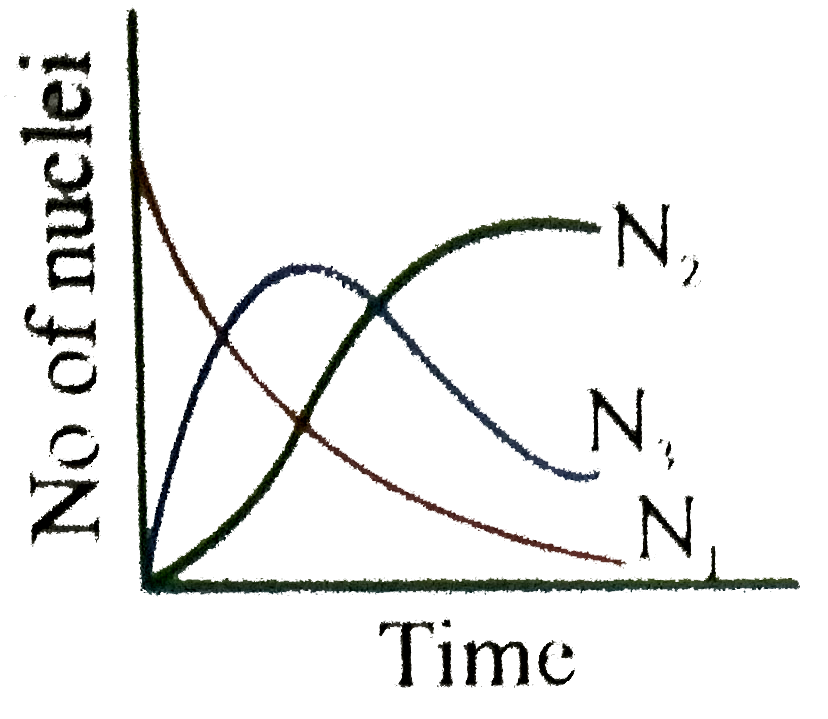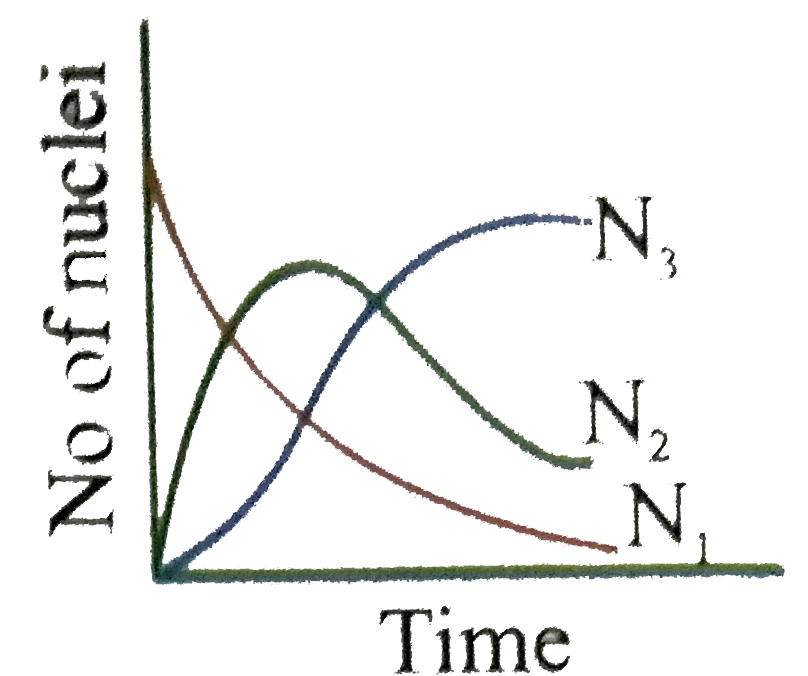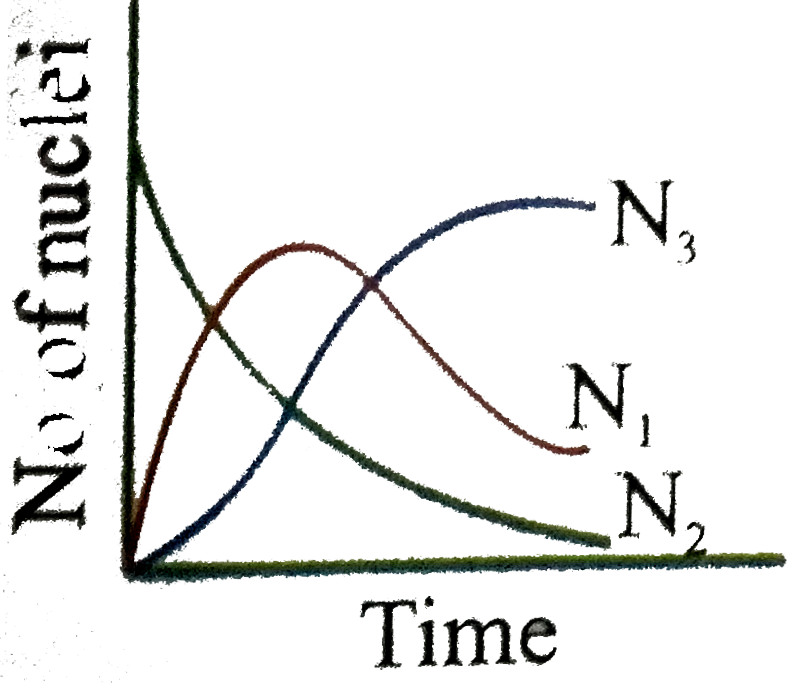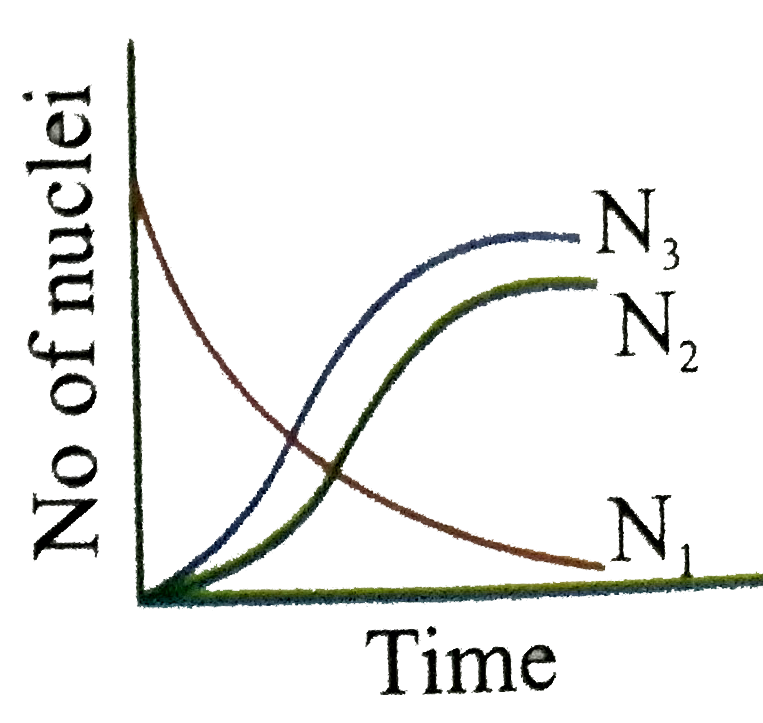Uranium .23892U is an ustable nucleus. It decays to Thorium .23892Th, which is again an unstable nucleus which further decays to .23491Pa. Let .23892U be called A of decay constant λ1 and .23490Th is called as B of decay constant λ2 and stable nuclei .23491Pa be called as C. Here A is called parent nucleus and B is called daughter nucleus of A. Any two adjacent nuclei may be consider parent or daughter nuclei A,B and C respectively at time 't'.
Then we can write Aλ1−−→Bλ2−−→C
Rate of disintergration of A=dN1dt=−λ1N1
Rate of disintergration of B=dN2dt=λ1N1−λ2N2
Rate of formation of nuclei C is equal to
dN3dt=−λ2N2
If at t=0, there are N0 number of nuclei of A where as nuclei B and C are absent in the sample Answer the following questions ltbgt Numeber of the nuclei of nuclei C at time t is
N0λ1λ2−λ1(eλ1t−eλ2t)
N0λ2λ2−λ1(e−λ1t−e−λ2t)
N0λ1λ2−λ1(eλ1t−eλ2t)
N0λ2λ2−λ1(eλ1t+eλ2t)
The correct Answer is:C
Step by step video, text & image solution for Uranium ._(92)^(238)U is an ustable nucleus. It decays to Thorium ._(92)^(238)Th, which is again an unstable nucleus which further decays to ._(91)^(234)Pa. Let ._(92)^(238)U be called A of decay constant lambda_(1) and ._(90)^(234)Th is called as B of decay constant lambda_(2) and stable nuclei ._(91)^(234)Pa be called as C. Here A is called parent nucleus and B is called daughter nucleus of A. Any two adjacent nuclei may be consider parent or daughter nuclei A, B and C respectively at time 't'. Then we can write Aoverset(lambda_(1))rarrBoverset(lambda_(2))rarrC Rate of disintergration of A=(dN_(1))/(dt)=-lambda_(1)N_(1) Rate of disintergration of B=(dN_(2))/(dt)=lambda_(1)N_(1)-lambda_(2)N_(2) Rate of formation of nuclei C is equal to (dN_(3))/(dt)=-lambda_(2)N_(2) If at t=0, there are N_(0) number of nuclei of A where as nuclei B and C are absent in the sample Answer the following questions ltbgt Numeber of the nuclei of nuclei C at time t is by Physics experts to help you in doubts & scoring excellent marks in Class 12 exams.
Updated on:21/07/2023Topper's Solved these Questions
- PHYSICS PART-IIIBOOK - FIITJEECHAPTER - PHYSICS PART-IIIEXERCISE - NUMERICAL BASED QUESTIONS WITH SINGLE CORRECT
8 Videos
- PHYSICS PART-IIIBOOK - FIITJEECHAPTER - PHYSICS PART-IIIEXERCISE - NUMERICAL BASED QUESTIONS DECIMAL TYPE
11 Videos
- PHYSICS PART-IIIBOOK - FIITJEECHAPTER - PHYSICS PART-IIIEXERCISE - ASSERTION -REASONING MCQ (SINGLE CORRECT)
12 Videos
- OPTICSBOOK - FIITJEECHAPTER - OPTICSEXERCISE - NUMERICAL BASED QUESTIONS
2 Videos
- PHYSICS PART2BOOK - FIITJEECHAPTER - PHYSICS PART2EXERCISE - Numerical Based Question Decimal Type
6 Videos
Similar Questions
Knowledge Check
Uranium .23892U is an ustable nucleus. It decays to Thorium .23892Th, which is again an unstable nucleus which further decays to .23491Pa. Let .23892U be called A of decay constant λ1 and .23490Th is called as B of decay constant λ2 and stable nuclei .23491Pa be called as C. Here A is called parent nucleus and B is called daughter nucleus of A. Any two adjacent nuclei may be consider parent or daughter nuclei A,B and C respectively at time 't'.
Then we can write Aλ1−−→Bλ2−−→C
Rate of disintergration of A=dN1dt=λ1N1
Rate of disintergration of B=dN2dt=λ1N1−λ2N2
Rate of formation of nuclei C is equal to
dN3dt=λ2N2
If at t=0, there are N0 number of nuclei of A where as nuclei B and C are absent in the sample Answer the following questions
Number of nuclei of B at any time t isAN0λ1λ2−λ1(eλ1t−eλ2t)BN0λ1λ2−λ1(e−λ1t−e−λ2t)CN0λ1λ2−λ1(e−λ1t−e−λ2t)DN0λ2λ2−λ1(e−λ1t+e−λ2t)Uranium .23892U is an ustable nucleus. It decays to Thorium .23892Th, which is again an unstable nucleus which further decays to .23491Pa. Let .23892U be called A of decay constant λ1 and .23490Th is called as B of decay constant λ2 and stable nuclei .23491Pa be called as C. Here A is called parent nucleus and B is called daughter nucleus of A. Any two adjacent nuclei may be consider parent or daughter nuclei A,B and C respectively at time 't'.
Then we can write Aλ1−−→Bλ2−−→C
Rate of disintergration of A=dN1dt=λ1N1
Rate of disintergration of B=dN2dt=λ1N1−λ2N2
Rate of formation of nuclei C is equal to
dN3dt=λ2N2
If at t=0, there are N0 number of nuclei of A where as nuclei B and C are absent in the sample Answer the following questions
The graph N1,N2 and N3 with time can be best represent byA B
B C
C D
D
Alpha decay of .23892U forms .23490Th. What kind of decay from .23490Th produces .23484Ac ?
AαBβCβ+(positron)Dγ -emission
.234U has 92 protons and 234 nucleons total in tis nucleus. It decays by emitting an alpha particle. After the decay it becomes:
View SolutionA nucleus of 23892U, originally at rest, emits an α-particle with a speed ν. Recoil speed of the daughter nucleus will be
View SolutionHow many neutrons are present in the nucleus 92U234 ?
View SolutionA radioactive nucleus .92X235 decays to .91Y231. Which of following particles are emitted ?
View SolutionOn decay of 92U238 to a stable nucleus 82Pb206 , the number of α and β particles emitted ar
View Solution
